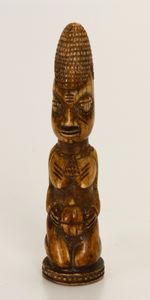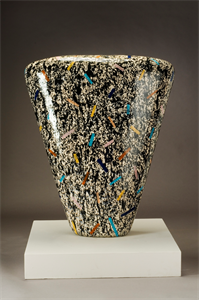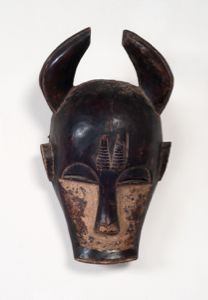
Yoruba-Owo Peoples
African
One of the best-known divination systems in Africa is that used among Yoruba peoples and referred to as Ifa. Ifa was performed by the "babalawo," or diviner, who made use of a number of artfully carved objects during the complicated process. Among the implements were a divination board, an elaborately carved cup for holding palm nuts used in the process, a carved tapper, usually in wood or ivory, for summoning the gods and ancestors, a beautifully beaded bag for containing some of the objects, and a large sculptural bowl for storage. The process involved the manipulation of sixteen palm nuts. The cast of the palm nuts determined a set of eight configurations. The 256 possible combinations, referred to as odu, each had a large body of oral poetry committed to memory by the diviner. When the palm nuts that determined the configuration were not in use, they were often accompanied in storage by a small ivory carving, most often representing a human head, sometimes a kneeling figure as in this example.
African
Female Figure
20th century
Object Type:
Sculpture
Dimensions:
5 1/8 in. x 1 1/4 in. x 1 1/2 in. (13.02 cm x 3.18 cm x 3.81 cm)
Medium and Support:
Ivory
Accession Number:
2013.0017.0034
Credit Line:
Gift of Dileep and Martha Mehta
One of the best-known divination systems in Africa is that used among Yoruba peoples and referred to as Ifa. Ifa was performed by the "babalawo," or diviner, who made use of a number of artfully carved objects during the complicated process. Among the implements were a divination board, an elaborately carved cup for holding palm nuts used in the process, a carved tapper, usually in wood or ivory, for summoning the gods and ancestors, a beautifully beaded bag for containing some of the objects, and a large sculptural bowl for storage. The process involved the manipulation of sixteen palm nuts. The cast of the palm nuts determined a set of eight configurations. The 256 possible combinations, referred to as odu, each had a large body of oral poetry committed to memory by the diviner. When the palm nuts that determined the configuration were not in use, they were often accompanied in storage by a small ivory carving, most often representing a human head, sometimes a kneeling figure as in this example.
Keywords
Click a term to view the records with the same keyword
Portfolio List
Click a portfolio name to view all the objects in that portfolio
This object is a member of the following portfolios:
Your current search criteria is: All Object records and [Object]Century is "Twentieth century".

 by Artist (513)
by Artist (513)

